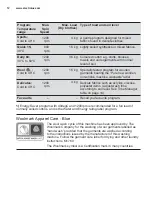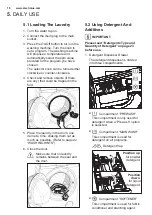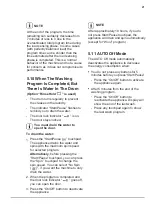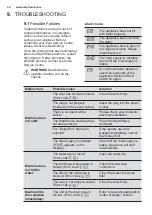
23
Blood
: treat fresh stains with cold water.
For dried stains, soak overnight in water
with a special detergent then rub in the
soap and water.
Oil based paint
: moisten with benzine
stain remover, lay the garment on a soft
cloth and dab the stain; treat several
times.
Dried grease stains
: moisten with
turpentine, lay the garment on a soft
surface and dab the stain with the
fingertips and a cotton cloth.
Stubborn stains may not be removed by
just water and detergent. It is therefore
advisable to treat them prior to washing.
Rust
: oxalic acid dissolved in hot water or
a rust removing product used in cold
water. Be careful with rust stains which
are not recent since the cellulose
structure will already have been damaged
and the fabric tends to hole.
Mould stains
: treat with bleach, rinse
well (whites and fast coloureds only).
Grass
: soap lightly and treat with bleach
(whites and fast coloureds only).
Ball point pen and glue
: moisten with
acetone (*), lay the garment on a soft
cloth and dab the stain.
Lipstick
: moisten with acetone (*) as
above, then treat stains with methylated
spirits. Remove any residual marks from
white fabrics with bleach.
Red wine
: soak in water and detergent,
rinse and treat with acetic or citric acid,
then rinse. Treat any residual marks with
bleach.
Ink
: depending on the type of ink,
moisten the fabric first with acetone (*),
then with acetic acid; treat any residual
marks on white fabrics with bleach and
then rinse thoroughly.
Tar stains
: first treat with stain remover,
methylated spirits or benzine, then rub
with detergent paste.
(*) do not use acetone on artificial silk.
Low sudsing detergent is required for this
washing machine to prevent oversudsing
problems, unsatisfactory washing result
and harm to the machine.
6.6 Detergents Type And
Quantity Of Detergent
Do not use wrong types of detergent,
such as Top Loading, Handwash
detergent or Soap-Based products in
your frontload washing machine. This
can result in excessive suds, longer
cycle time, low spin speeds, poor
rinsing and overloading of the motor.
The choice and quantity of detergent will
depend on ;
type of fabric (delicates, woollens,
cottons, etc.) ;
degree of soil ;
size of the load ;
wash temperature ; and
hardness of the water used.
the colour of clothes ;
Information on hardness of the water in
your area can be obtained from the
relevant water supply company, or from
your local authority.
Water hardness is classified by so-called
“degrees” of hardness.
The choice of detergent and use of
correct quantities not only affects your
wash performance, but also helps to
avoid waste and protect the environment.
Although biodegradable detergents
contain substances which in large
quantities can upset the delicate balance
of nature.
Low sudsing detergents designed for
front load washing machines are labelled
“Front Loading”, “high efficiency”, “HE”,
such as Cold Power for Front Loaders or
“Matic”.
Quantity of detergent to be
used
Summary of Contents for EWF7524CDWA
Page 41: ...43 ...
















































